Roman Catholic Archdiocese of Miami
 From Wikipedia - Reading time: 20 min
From Wikipedia - Reading time: 20 min
Archdiocese of Miami Archidioecesis Miamiensis Arquidiócesis de Miami Achidyosèz Miami | |
|---|---|
 Cathedral of Saint Mary | |
 Coat of arms | |
| Location | |
| Country | |
| Territory | Miami-Dade, Broward and Monroe counties in the state of Florida |
| Ecclesiastical province | Province of Miami |
| Statistics | |
| Population - Total - Catholics | (as of 2018) 4,752,179 1,300,000 (27%) |
| Parishes | 109 |
| Schools | 62 |
| Information | |
| Denomination | Catholic |
| Sui iuris church | Latin Church |
| Rite | Roman Rite |
| Established | October 7, 1958 |
| Cathedral | Cathedral of Saint Mary |
| Patron saint | Our Lady of the Immaculate Conception |
| Current leadership | |
| Pope | Francis |
| Archbishop | Thomas Wenski |
| Auxiliary Bishops | Enrique Esteban Delgado |
| Bishops emeritus | John Favalora |
| Map | |
 | |
| Website | |
| miamiarch.org | |
The Archdiocese of Miami (Latin: Archidioecesis Miamiensis, Spanish: Arquidiócesis de Miami, Haitian Creole: Achidyosèz Miami) is a Latin Church archdiocese of the Catholic Church in South Florida in the United States. It is the metropolitan see for the Ecclesiastical Province of Miami, which covers all of Florida. The Archdiocese of Miami contains the Florida counties Broward, Miami-Dade and Monroe.
Formed in 1958, the archdiocese added many Cuban members following the Cuban Revolution in 1959. It was involved in Operation Pedro Pan, a clandestine operation to bring Cuban children to South Florida. Starting in the late 1990s or early 2000s it has faced a sexual abuse scandal in which at least 90 minors made claims of sexual abuse as of 2003.
The archdiocese operates two hospitals and other healthcare facilities. It runs 60 elementary or middle schools, 13 high schools, and two universities. It celebrates mass in at least a dozen languages.
The Cathedral of Saint Mary is the mother church of the archdiocese. As of 2023, the archbishop of Miami is Thomas Wenski.
Structure
[edit]As of 2021, the Catholic population in the archdiocese was approximately 824,000, served by 271 priests in 102 parishes.[1]
The archdiocese celebrates mass in at least a dozen languages.[2] It operates two schools for the disabled, 60 elementary/middle schools, 13 high schools, two universities and two seminaries.[3][4] The archdiocese operates Radio, print, and television media outlets.[5]
The archdiocese operates two hospitals, nine health care centers, three homes for the aged, and two cemeteries.[6] The archdiocesan charities include homeless shelters, legal services for the poor, an HIV/AIDS ministry, and the Missionaries of Charity and Society of Saint Vincent de Paul ministries to the poor.[7][8][9][10][11][12] Catholic Charities of the Archdiocese of Miami is a separate non-profit organization operated by the archdiocese.[6][13]
History
[edit]1500 to 1550
[edit]The first Catholic presence in present-day Florida was the expedition of the Spaniard Juan Ponce de León, who arrived somewhere on the Gulf Coast in 1513. Hostility from the native Calusa people prevented him from landing. De Leon returned to the region with a colonizing expedition in 1521, landing near either Charlotte Harbor or the mouth of the Caloosahatchee River. His expedition had 200 men, including several priests.[14]
In 1539, Spanish explorer Hernando De Soto, hoping to find gold in Florida, landed near present day Port Charlotte or San Carlos Bay. He named the new territory "La Bahia de Espiritu Santo," in honor of the Holy Spirit.[15] DeSoto led an expedition of 10 ships and 620 men. His company included 12 priests, there to evangelize the Native Americans. His priests celebrated mass almost every day.[15] Unwilling to attack such a large expedition, the Calusa evacuated their settlements near the landing area. The De Soto expedition later proceeded to the Tampa Bay area and then into central Florida.
The Spanish missionary Reverend Luis de Cáncer arrived by sea with several Dominican priests in present day Bradenton in 1549. Encountering a seemingly peaceful party of Tocobaga clan members, they decided to travel on to Tampa Bay. Several of the priests went overland with the Tocobaga while Cáncer and the rest of the party sailed to Tampa Bay to meet them.[16]
Arriving at Tampa Bay, Cáncer learned, while still on his ship, that the Tocobaga had murdered the priests in the overland party. Ignoring advice to leave the area, Cáncer went ashore, where he too was murdered.[16] The Spanish attempted to establish another mission in the Tampa Bay area in 1567, but it was soon abandoned.[17]
1550 to 1770
[edit]The first Catholics in Eastern Florida were a group of Spanish Jesuits who founded a mission in 1566 on Upper Matecumbe Key in the Florida Keys. After several years of disease and turbulent relations with the Native American inhabitants, the missionaries returned to Spain.[18]The Spanish attempted to establish another mission in the Tampa Bay area in 1567, but soon abandoned it.[19]
In 1571, Spanish Jesuit missionaries made an brief, unsuccessful trip to Northern Florida. Two years later, in 1573, several Spanish Franciscan missionaries arrived in present day St. Augustine. They established the Mission Nombre de Dios in 1587 at a village of the Timucuan people.[20] By 1606, Florida was under the jurisdiction of the Archdiocese of Havana in Cuba.
In 1565, the Spanish explorer Pedro Menéndez de Avilés, the founder of Saint Augustine and Governor of Spanish Florida, brokered a peace agreement with the Calusa peoples. This agreement allowed him to build the San Antón de Carlos mission at Mound Key in what is now Lee County. Menéndez de Avilés also built a fort at Mound Key and established a garrison.
San Antón de Carlos was the first Jesuit mission in the Western Hemisphere and the first Catholic presence within the Venice area. Juan Rogel and Francisco de Villareal spent the winter at the mission studying the Calusa language, then started evangelizing among the Calusa in southern Florida. The Jesuits built a chapel at the mission in 1567. Conflicts with the Calusa soon increased, prompting Menéndez de Avilés to abandon San Antón de Carlos in 1569.[21]
1700 to 1800
[edit]By the early 1700's, the Spanish Franciscans had established a network of 40 missions in Northern and Central Florida, with 70 priests ministering to over 25,000 Native American converts.[22] However, raids by British settlers and their Creek Native American allies from the Carolinas eventually shut down the missions. Part of the reason for the raids was that the Spanish colonists gave refuge to enslaved people who had escaped the Carolinas.[23] A number of Timucuan Catholic converts in Northern Florida were slaughtered during these incursions.
After the end of the French and Indian War in 1763, Spain ceded all of Florida to Great Britain for the return of Cuba. Given the antagonism of Protestant Great Britain to Catholicism, the majority of the Catholic population in Florida fled to Cuba.[24]
After the American Revolution, Spain regained control of Florida in 1784. from Great Britain.[25] In 1793, the Vatican changed the jurisdiction for Florida Catholics from Havana to the Apostolic Vicariate of Louisiana and the Two Floridas, based in New Orleans.[26]
1800 to 1900
[edit]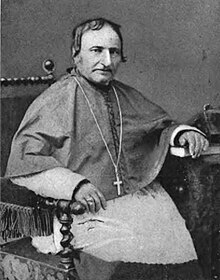
In the Adams–Onís Treaty of 1819, Spain ceded all of Florida to the United States, which established the Florida Territory in 1821.[27] In 1825, Pope Leo XII erected the Vicariate of Alabama and Florida, which included all of Florida, based in Mobile ,Alabama.[28]
In 1850, Pope Pius IX erected the Diocese of Savannah, which included Georgia and all of Florida east of the Apalachicola River. That same year, Bishop Francis X. Gartland of Savannah sent Reverend John F. Kirby to Key West to tend to a growing Catholic community there. He constructed Saint Mary Star of the Sea Church in Key West in 1852.[29]In 1858, Pius IX moved Florida into a new Apostolic Vicariate of Florida and named Bishop Augustin Verot as vicar apostolic.[30] Since the new vicariate had only three priests, Vérot traveled to France in 1859 to recruit more. He succeeded in bringing back seven priests to Florida.[31] The first Catholic parish in Tampa, St. Louis, was founded in 1859.
In 1870, Pius IX elevated the Vicariate of Florida into the Diocese of St. Augustine and named Vérot as its first bishop.[32] The new diocese covered all of Florida except for the Florida Panhandle region. Gesù Parish in Miami, founded in 1896, was the first parish founded in South Florida outside of the Florida Keys.[33]
1900 to 1968
[edit]The first Catholic church in Homestead was Sacred Heart, constructed in 1917.[34] In the 1950s and early 1960s, St. Augustine bishop Joseph Hurley purchased land throughout South Florida in anticipation of a future population boom.[35] Dozens of Catholic churches, schools and cemeteries were later built on land purchased by Hurley.[2]
Pope Pius XII erected the Diocese of Miami on October 7, 1958, naming Auxiliary Bishop Coleman Carroll from the Diocese of Pittsburgh as the first bishop of Miami. On its formation, the new diocese included the 16 southern counties in Florida, with a Catholic population of approximately 200,000.
The Cuban Revolution in 1959 triggered a wave of Cuban immigration to South Florida, increasing the Catholic population in the region. Carroll established the Catholic Welfare Bureau to assist these immigrants. Between 1960 and 1962, the bureau ran a clandestine operation, Operation Pedro Pan, to bring 14,000 Cuban children to South Florida.
1968 to 1977
[edit]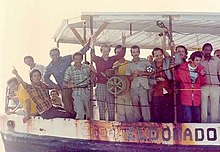
On March 2, 1968, Pope Paul VI erected the Dioceses of St. Petersburg and Orlando, taking eight counties from the Diocese of Miami. At the same time, the pope elevated the Diocese of Miami to the Archdiocese of Miami, naming Carroll as archbishop.[36]
During the American Civil Rights Movement of the 60's, Carroll was influential in stemming threatened racial riots in Miami. He desegregated the Catholic schools in the archdiocese ten years before any other diocese in Florida.[37][38] Carroll was a co-founder of the Community Relations Board, which worked to "quell waves of misunderstanding, discrimination and discontent which often threatened to flood South Florida's multi-ethnic community."[37]
1977 to 2003
[edit]After Carroll died 1977, Paul VI named Bishop Edward McCarthy as Miami's archbishop.[39][40] McCarthy oversaw the construction in Miami Shores of the Pastoral Center - Florida Catholic for the archdiocese and restructured most senior operational divisions. He established the Office of Lay Ecclesial Ministry, the Office of Evangelization and the permanent diaconate program. In 1980, he offered support and assistance to Cuban refugees during the Mariel Boat Lift. The following year, he supported the rights of Haitian immigrants who were detained by the US Immigration Service under the Wet Foot, Dry Foot policy. Responding to the needs of this new immigration, McCarthy opened the Pierre Toussaint Haitian Catholic Center in Miami.[40][41] McCarthy retired in 1994.[2]
On November 3, 1994, Pope John Paul II appointed Bishop John C. Favalora of St. Petersburg as the third archbishop of Miami. During his tenure, Favalora built two new high schools and nine grade schools. Favalora also initiated Vision 2000, a five-year fundraising campaign to support Catholic education and outreach institutions in the archdiocese. Vision 2000 raised $90 million.[2]
2003 to present
[edit]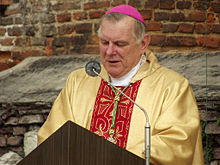
On July 11, 2003, John Paul II appointed Auxiliary Bishop Thomas Wenski of Miami to lead the Diocese of Orlando.[42][43] With substantial immigration of predominantly Catholic South and Central Americans to the South Florida area, the Catholic population reached 25% of the total population of South Florida. Waves of immigrants from other parts of the world, including Asia and Africa, led to priests celebrating mass in over a dozen different languages.[2][44]
In 2009, the Vatican named Reverend Fernando Isern, pastor of Our Lady of Lourdes Parish in Kendall, as the next bishop of the Diocese of Pueblo. He was the 11th archdiocesan priest to become bishop since 1958.[45]
On April 20, 2010, Pope Benedict XVI accepted Favarola's resignation and appointed Bishop Thomas Wenski of Orlando as his successor.[46] On June 1, 2010, Wenski was installed as the fourth archbishop of Miami at the Cathedral of Saint Mary.[47] Wenski in June 2021 praised the archdiocesan community for its support of victims of the collapse of the Champlain Towers condominium building in Surfside. [48]
In February 2023, the archdiocese offered refuge to Nicaraguan priests and seminarians who had been exiled by the Government of Nicaragua.[49]As of November 2024, Wenski is the current archbishop
Sexual abuse
[edit]Bishops
[edit]Archbishops of Miami
[edit]- Coleman Carroll (1958–1977), elevated to Archbishop in 1968
- Edward Anthony McCarthy (1977–1994)
- John Favalora (1994–2010)
- Thomas Wenski (2010–present)
Auxiliary bishops
[edit]- René Gracida (1968–1975), appointed Bishop of Pensacola-Tallahassee and later Bishop of Corpus Christi
- John Nevins (1979–1984), appointed Bishop of Venice
- Agustin Roman (1979–2013)
- Norbert Dorsey (1986–1990), appointed Bishop of Orlando
- Gilberto Fernandez (1997–2002)
- Thomas Wenski (1997–2003), appointed Coadjutor Bishop and later Bishop of Orlando and Archbishop of Miami
- Felipe Estévez (2004–2011), appointed Bishop of Saint Augustine
- John Noonan (2005–2010), appointed Bishop of Orlando
- John Fitzpatrick (1968–1971), appointed Bishop of Brownsville
- Peter Baldacchino (2014–2019), appointed Bishop of Las Cruces
- Enrique Esteban Delgado (2017–present)
Other priests of the diocese who became bishops
[edit]- Ambrose De Paoli, appointed Apostolic Nuncio and Titular Archbishop in 1983
- Fernando Isern, appointed Bishop of Pueblo in 2009
- Robert Nugent Lynch, appointed Bishop of Saint Petersburg in 1995
Education
[edit]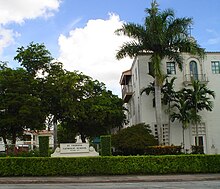

Schools
[edit]As of 2024, the Archdiocese of Miami had an enrollment of 35,000 students in 68 schools and four dedicated pre-schools.[4]
| High school | Opened | District | City |
|---|---|---|---|
| Archbishop Coleman F. Carroll High School | 1998 | The Hammocks | Unincorporated area |
| Archbishop Curley-Notre Dame High School | 1953 | Buena Vista | Miami |
| Archbishop Edward A. McCarthy High School | 1998 | Southwest Ranches | |
| Belen Jesuit Preparatory School | 1854 | Tamiami | Miami |
| Cardinal Gibbons High School | 1961 | Fort Lauderdale | |
| Carrollton School of the Sacred Heart | 1961 | Coconut Grove | Miami |
| Chaminade-Madonna College Preparatory School | 1960 | Hollywood | |
| Christopher Columbus High School | 1958 | Westchester | Unincorporated area |
| Immaculata-LaSalle High School | 1958 | Coconut Grove | Miami |
| Monsignor Edward Pace High School | 1961 | Miami Gardens | |
| Our Lady of Lourdes Academy | 1963 | Ponce-Davis | |
| St. Brendan High School | 1975 | Westchester | Unincorporated area |
| St. Thomas Aquinas High School | 1936 | Fort Lauderdale |
Religious education
[edit]The archdiocese offers religious education classes for children who attend public or private schools. In 1997, Favalora started requiring all volunteers, employees, teachers and priests working with children to be fingerprinted and undergo a background check.[50] The archdiocese also offers adult religious education classes.
Universities
[edit]The Archdiocese of Miami administers St. Thomas University in Miami. In 1961, a group of Augustinian priests arrived in Miami after being expelled from Cuba after the Cuban Revolution. They founded Biscayne College, which the archdiocese took over in 1988 and renamed as St. Thomas University.[51]
St. Thomas offers Bachelor of Arts, Master of Arts, Master's degree, Master of Business Administration, M.Acc., Doctor of Education, and Doctor of Philosophy programs. It offers several joint degree programs and an accelerated B.A./J.D. as well. The School of Law at St. Thomas was fully accredited by the American Bar Association in February 1995, and offers the Juris Doctor degree (J.D.) as well as the Masters of Law (LL.M) degrees.[52]
In 1940, the Dominican sisters, along with Bishop Patrick Berry of St. Augustine, founded Barry College for women in Miami Shores. It became Barry University in 1981[51]
Seminaries
[edit]
St. John Vianney College Seminary and Graduate School in Miami is sponsored by the archdiocese. It offers a two-year pre-theology program for seminarians with a bachelor's degree. St. John Vianney also offers a Bachelor of Philosophy program for seminarians lacking a college degree. It also provides language immersion programs.[53]
St. Vincent de Paul Regional Seminary in Boynton Beach is sponsored by all the Florida dioceses. It offers a master's degree in Theology and Theological Studies and a First Professional Degree in Divinity and Ministry.[54][55]
Redemptoris Mater Archdiocesan Missionary Seminary in Hialeah is a diocesan seminary whose graduates are assigned by the archbishop to parish or missionary assignments. Its seminarians attend classes at St. John Vianney or St. Vincent de Paul.[3]
Catholic Charities of Miami
[edit]
Catholic Charities of Miami is a separate non-profit organization operated by the Archdiocese of Miami. It is part of a national network of Catholic Charities operated in each diocese. In 2007, Catholic Charities of Miami claimed to be the largest nongovernmental provider of services to the needy in South Florida.[13]
Catholic Charities of Miami was founded in 1931 during the Great Depression with four Miami-area pastors and lay members of the Society of Saint Vincent de Paul.[56] As of 2024, Catholic Charities services include:
- Alcohol and substance abuse services
- child development services
- Behavioral health services
- Elderly Services
- Homeless prevention and rapid re-housing
- Housing services
- immigrant and refugee services[57]
Health
[edit]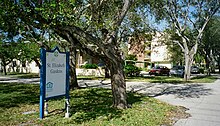
Catholic Health Services operates 26 facilities in Broward and Miami-Dade Counties for the archdiocese. These included HCA Florida Mercy Hospital in Miami and Holy Cross Hospital in Ft. Lauderdale.[58]
Catholic Hospice is a partnership between the archdiocese and Mercy Hospital. It provides end of life care to terminally ill patients and their families in Miami-Dade and Monroe counties.[59]
Catholic Cemeteries
[edit]Catholic Cemeteries operates two cemeteries:
- Our Lady of Mercy – Miami-Dade County
- Our Lady Queen of Heaven – Broward County[60]
Outreach
[edit]Lay movements and ministries
[edit]Lay men and women operate over 60 movements and ministries for the archdiocese. As of 2024, these ministries included:
- Airport Ministry
- Apostleship of the Sea
- Ascending Life
- Catholic Campus Ministry
- Charismatic Renewal
- Courage International
- Miami Archdiocesan Council of Catholic Women
- Lay Groups
- Marian movements
- Marian Center for the disabled
- Mission Office
- Office of Ecumenical and Inter-faith Relations
- Office of Family Life
- Prison ministry
- Respect Life Office
- Youth Ministry
- Young Adult Ministry
The archdiocese also helps support what it terms as crisis pregnancy centers, along with a post-abortion counseling program through Project Rachel, an anti-abortion initiative of the US Conference of Catholic Bishops.[61]
Retreats
[edit]
Morning Star Renewal Center in Pinecrest is a retreat house operated by lay people for the archdiocese. The center provides group retreats and offers spiritual formation activities.[62]
Charities
[edit]- Camillus House[63]
- HIV/AIDS shelter[9]
- Missionaries of Charity of Mother Theresa[64]
- Society of Saint Vincent de Paul[65]
- social advocacy groups[11]
Media
[edit]PAX Catholic Communications
[edit]Radio Paz is a Spanish-language AM station founded in 1990. It is broadcast on WACC 830 AM.[66]
Florida Catholic
[edit]
The archdiocese publishes a localized version of the Florida Catholic newspaper every two weeks. Each issue contains a message from the archbishop, spiritual reflections on the scripture readings for the week, news reporting on various events happening around the archdiocese and the world, and a digest of upcoming events featured around the archdiocese among other features. Florida Catholic is also published online.
Florida Catholic produced a series entitled "Building the City of God", which profiles the personal side of priests. It won a Communicator Award of Distinction for print media "Marketing/Promotion/Campaign".[67]
Content provision
[edit]The archdiocese produces English and Spanish masses to air on local television stations, along with content for the Internet and video.[68] One video, entitled "Walking in the Light of Christ," received a Videographer Award of Excellence in 2008 from the Association of Marketing and Communication Professionals.[69][70]
See also
[edit]- Catholic Church by country
- Catholic Church hierarchy
- History of Miami
- List of the Catholic dioceses of the United States
- List of churches in the Roman Catholic Archdiocese of Miami
- Pedro Menéndez de Avilés
- Sexual abuse scandal in Miami archdiocese
- Timeline of Miami, Florida history
References
[edit]- ^ "Miami (Archdiocese) [Catholic-Hierarchy]". www.catholic-hierarchy.org. Retrieved 2024-10-30.
- ^ a b c d e Tanasychuk, John (2007-10-06). "Archdiocese is set for 50th anniversary". South Florida Sun-Sentinel. Archived from the original on July 22, 2009. Retrieved 2009-03-09.
- ^ a b "ADOM :: Seminaries". www.miamiarch.org. Retrieved 2024-10-30.
- ^ a b "ADOM :: Education". www.miamiarch.org. Retrieved 2024-10-30.
- ^ "Miami Archdiocese at a Crossroads in 50th year". Miami Herald. 2007-10-07. Retrieved 2007-10-07. [dead link]
- ^ a b The Daily Florida Catholic Newspaper (April 10, 2008). "2007 Archdiocese of Miami Official Catholic Directory". The Florida Catholic Newspaper. pp. A4.
- ^ Camillus House. "Camillus House Website". Camillus House. Retrieved 2007-08-16.
- ^ Catholic Legal Services. "Catholic Legal Services". Catholic Legal Services. Retrieved 2007-08-16.
- ^ a b What is the Volunteer Friendship Program?. "Volunteer Friendship Program". Catholic Charities of the Archdiocese of Miami Inc. Archived from the original on 2008-11-22. Retrieved 2008-12-09.
- ^ Missionaries of Charity. "Missionaries of Charity website". Missionaries of Charity. Archived from the original on 2007-08-19. Retrieved 2007-08-16.
- ^ a b What We Do. "Catholic Charities of the Archdiocese of Miami, Inc. website". Catholic Charities of the Archdiocese of Miami, Inc. Archived from the original on October 24, 2008. Retrieved 2008-12-09.
- ^ "St Vincent de Paul". Archdiocese of Miami. Retrieved 2008-12-09.
- ^ a b Archdiocese of Miami (2007). "Catholic Charities Who We Are". Archdiocese of Miami Catholic Charities. Archived from the original on July 31, 2007. Retrieved October 8, 2007.
- ^ Davis, T. Frederick (1935). "History of Juan Ponce de Leon's Voyages to Florida". Florida Historical Quarterly. 14 (1): 51–66.
- ^ a b Robert S. Weddle (2006). "Soto's Problems of Orientation". In Galloway, Patricia Kay (ed.). The Hernando de Soto Expedition: History, Historiography, and "Discovery" in the Southeast (New ed.). University of Nebraska Press. p. 223. ISBN 978-0-8032-7122-7. Retrieved 17 February 2017.
- ^ a b Burnett, Gene (1986). Florida's Past, volume 1. Pineapple Press. p. 156. ISBN 1561641154. Retrieved October 16, 2012.
- ^ "History of our Diocese". Catholic Diocese of Pensacola-Tallahassee. Retrieved 2023-08-12.
- ^ "History of the Parish 1556–1850". Basilica of St. Mary Star of the Sea. Archived from the original on 2014-05-29. Retrieved 2014-05-28.
- ^ "History of our Diocese". Catholic Diocese of Pensacola-Tallahassee. Retrieved 2023-08-12.
- ^ "The Church and the Missions". St. Augustine: America's Ancient City. Retrieved 2024-10-25.
- ^ "History | Florida State Parks". www.floridastateparks.org. Retrieved 2023-08-16.
- ^ "Expansion of Missions and Ranches". St. Augustine: America's Ancient City. Retrieved 2024-10-25.
- ^ "The English Menace & African Resistance". St. Augustine: America's Ancient City. Retrieved 2024-10-25.
- ^ "Introduction". St. Augustine: America's Ancient City. Retrieved 2024-10-25.
- ^ "Introduction". St. Augustine: America's Ancient City. Retrieved 2024-10-25.
- ^ "New Orleans (Archdiocese) [Catholic-Hierarchy]". www.catholic-hierarchy.org. Retrieved 2024-10-25.
- ^ "European Exploration and Colonization – Florida Department of State". dos.myflorida.com. Retrieved 2023-03-27.
- ^ "New Orleans (Archdiocese) [Catholic-Hierarchy]". www.catholic-hierarchy.org. Retrieved 2024-10-25.
- ^ "History of Our Parish | The Basilica of Saint Mary Star of the Sea". Retrieved 2023-05-29.
- ^ "Savannah (Diocese) [Catholic-Hierarchy]". www.catholic-hierarchy.org. Retrieved 2023-08-12.
- ^ Michael V. Gannon, The Cross in the Sand (University of Florida, 1983) pp. 167-168.
- ^ "Bishop Jean Marcel Pierre Auguste Vérot [Catholic-Hierarchy]". www.catholic-hierarchy.org. Retrieved 2022-05-21.
- ^ "<span>About Us</span><br />". Gesù Church. Retrieved 2023-05-29.
- ^ "Catholic Church | Sacred Heart Catholic Church | United States". Sacred Heart. Retrieved 2023-05-29.
- ^ Gannon, Michael (2007-10-30). "The Builder Bishop". Saint Augustine Catholic. Archived from the original on July 15, 2007. Retrieved 2007-10-30.
- ^ Miami Archdiocese. "Archdiocese of Miami: History - Made an Archdiocese". Miami Archdiocese. Retrieved 2007-04-20.
- ^ a b The Archdiocese of Miami (2007). History of the Archdiocese of Miami 1958-2008. Editions du Signe. p. 27. ISBN 978-2-7468-1935-1.
- ^ The Florida Memory Project. "Florida Timeline". The Florida Memory Project. Archived from the original on 2007-10-11. Retrieved 2007-11-10.
- ^ Miami Archdiocese. "Archdiocese of Miami: History - First Successor". Miami Archdiocese. Retrieved 2007-05-26.
- ^ a b McCarthy High School. "Archbishop McCarthy High School – About Us". McCarthy High School. Archived from the original on 2007-04-28. Retrieved 2007-05-26.
- ^ Miami Archdiocese. "Archdiocese of Miami: History - More Exiles". Miami Archdiocese. Retrieved 2007-04-19.
- ^ Grossman, Cathy Lynn (2003-07-23). "Vacancies Occupy Catholic Church". USA Today. Retrieved 2007-08-16.
- ^ Grossman, Cathy Lynn (2003-07-02). "Church vacancies will leave room at the top of dioceses". USA Today. Archived from the original on July 19, 2009. Retrieved 2007-08-16.
- ^ Florida Trend. "Population Still Growing". Trend Magazines Inc. Retrieved 2007-09-25.
- ^ Miami Herald Staff Report (2009-10-16). "South Florida priest will become bishop in Colorado". Miami Herald.[dead link]
- ^ "New Miami Archbishop Thomas Wenski has strong ties to South Florida". Miami Herald. Retrieved 2010-06-01.[dead link]
- ^ "Thomas Wenski becomes new archbishop of Miami". Miami Herald. Retrieved 2010-06-01.[dead link]
- ^ "'Everybody is coming together': Miami archbishop lauds response to building collapse". Catholic News Agency. Retrieved 2024-10-30.
- ^ CNA. "US archdiocese offers to take in priests exiled from Nicaragua". Catholic News Agency. Retrieved 2024-10-30.
- ^ United States Conference of Catholic Bishops (2005). "Charter for the Protection of Children and Young People". United States Conference of Catholic Bishops. Retrieved 2007-10-08.
- ^ a b "ADOM :: Education". www.miamiarch.org. Retrieved 2024-10-30.
- ^ Saint Thomas University. "Saint Thomas University website". Saint Thomas University. Archived from the original on August 14, 2007. Retrieved 2007-08-16.
- ^ "Home". St. John Vianney College Seminary. Retrieved 2023-05-29.
- ^ St. Vincent De Paul Seminary. "St Vincent De Paul Regional Seminary website". St. Vincent De Paul Seminary. Retrieved 2007-08-16.
- ^ Arbiteronline.com. "Catholic Leaders Seek Young Religious Recruits On The Web". Archived from the original on 2009-07-20. Retrieved 2007-09-25.
- ^ "ADOM :: Charities". www.miamiarch.org. Retrieved 2024-10-30.
- ^ "Our Services". Retrieved 2024-10-30.
- ^ "ADOM :: Health & Hospice". www.miamiarch.org. Retrieved 2024-10-30.
- ^ "Hospice Services". Catholic Health Services. Retrieved 2024-10-30.
- ^ "ADOM :: Cemeteries". www.miamiarch.org. Retrieved 2024-10-30.
- ^ "ADOM :: Ministries". www.miamiarch.org. Retrieved 2024-10-30.
- ^ "About | United States | Morningstar Renewal Center". MorningStar Renewal. Retrieved 2024-10-30.
- ^ "Camillus House". Camillus House. Retrieved 2024-10-30.
- ^ "ADOM :: Charities". www.miamiarch.org. Retrieved 2024-10-30.
- ^ "ADOM :: Charities". www.miamiarch.org. Retrieved 2024-10-30.
- ^ "ADOM :: Communications". www.miamiarch.org. Retrieved 2024-10-30.
- ^ The Archdiocese of Miami (2007). "Building the City of God". The Archdiocese of Miami. Retrieved October 8, 2007.
- ^ Television. "The Archdiocese of Miami". miamiarch.org. Retrieved 2008-12-10.
- ^ Video earns another award. "Archdiocese of Miami News Briefs". thefloridacatholic.org. Archived from the original on November 21, 2008. Retrieved 2008-12-10.
- ^ 2008 Competition Award of Excellence Winners. "The Videographer Awards". videoawards.com. Archived from the original on 2008-12-07. Retrieved 2008-12-10.
{{cite web}}: CS1 maint: numeric names: authors list (link)
External links
[edit]- Roman Catholic Archdiocese of Miami Official Site
- Roman Catholic Archdiocese of Miami Official Site (miamiarchdiocese.org) at the Wayback Machine (archive index)
- Roman Catholic Archdiocese of Miami Official Site (archdioceseofmiami.org) at the Wayback Machine (archive index)
- Archdiocese of Miami Department of Schools at the Wayback Machine (archive index)
- Catholic Charities of the Archdiocese of Miami
- The Florida Catholic Newspaper
- Catholic Health Services
- Catholic Hospice Care
- St. John Vianney Seminary, Miami
- St. Vincent De Paul Regional Seminary, Boynton Beach
 KSF
KSF
